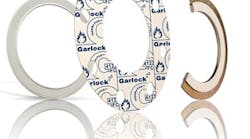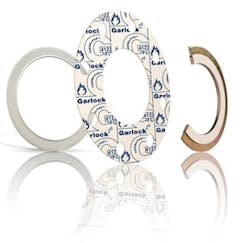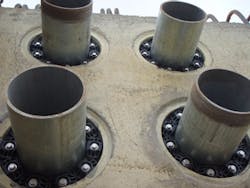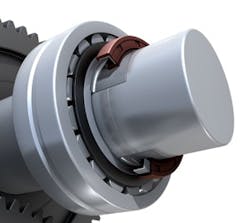Chemical makers are demanding more from seal technology suppliers than ever before. Vendors not only are expected to provide innovative solutions that work in extreme process conditions, but also to offer comprehensive emissions reduction and maintenance programs.
One result is the development of more niche products. This move by seal manufacturers, often stemming from new legislation, is an important issue for the European Sealing Association (ESA), Tregarth, Wales. "As some of the traditional (and lower technology) sealing products are tending towards commodities, manufacturers in Europe are switching their focus onto higher technology products which provide improved sealing performance, often directed towards specific applications," notes Brian Ellis, its secretary general.
Member companies are giving much more emphasis to customer training, especially for gasket and packings installations, he says. "This is because the ultimate performance (and lifetime) of a seal is extremely dependent upon getting it installed correctly. This has been compounded because the majority of the chemical, petrochemical and process industries have downsized their own in-house engineering departments and rely increasingly on outsourcing for their maintenance, where there is no guarantee of adequate education and training in the engineers. As an industry, we have struggled with this challenge for some time, initially by publishing a wide range of technical publications (in many languages) to provide guidance in these areas, but now we are into a program which includes: developing a training and accreditation standard aimed at engineering fitters; developing a training and accreditation scheme across Europe; and working with our colleagues in the FSA [the Fluid Sealing Association in the U.S.] to develop an educational webinar on packings installation."
Turning to another issue, Ellis voices concern about the ongoing challenge of sourcing fluorospar, the fundamental material in all fluoropolymers. China, the major supplier, has blocked its export, making fluoroelastomers increasingly hard to obtain. "The U.S. government is putting pressure on China to stop the block, but end-users — and especially chemical companies — are struggling to get products, and prices are rising enormously," he says.
Compounding the problem, many major suppliers of fluoroelastomer precursors cut production following a fall in demand in 2008 and then refocused on higher-value-added products. So, precursor output still falls short of prior levels. "You have two things intertwined here: there is a likely huge cost increase in the short term on the precursor materials, but the extremely limited availability of these precursors may go on for decades. It's like a perfect storm," explains Ellis.
"The only way out may be to put our hope in the development of good alternative sealing materials in as short a timeframe as possible," he concludes.
BETTER GASKETS
One new alternative material comes from Garlock Sealing Technologies (GST), Palmyra, N.Y. At the end of June, it launched Therma-Pur, a blended proprietary material designed for temperatures up to 1,800°F (1,000°C) (Figure 1). The material suits applications such as process drying equipment, mineral and fertilizer processing, oil and gas production, and cogeneration systems.
"Prior to its launch, over 2,000 gaskets underwent extensive beta testing at various customer locations in numerous industries. It's been in development for over three years and we are looking at it as an important new opportunity," says Jim Drago, manager, business development and integration. "By doing extensive beta testing in many industries, we built up a wealth of experience. After one free sample run, beta-customers were already ordering prototypes," he adds.
"We took this development from the ground up, identifying brand new materials in order to develop something different and we now have patents pending. There are lots of downsides with traditional vermiculite and mica-based materials. For example, mica is very fragile, making cutting difficult, and its plate structure typically results in quite high permeability, which affects its sealing quality. Vermiculite suffers from similar problems," notes Matt Tones, director of product management.
Meanwhile, in response to operating companies' increasing use of energy-saving variable frequency motor drives, this year GST introduced its shaft grounded bearing insulator, the SGi.
Plants are encountering voltage potentials on shafts when they install variable frequency drives, explains Earl Rogalski, director, customer driven innovation. The resultant voltage discharges act like lightning strikes, melting bearing steel and causing fluted bearings.
"With the SGi properly installed, the user should never have a voltage potential as the seal provides the path of least resistance to ground. We are seeing more interest in the U.S. for this because of the various regulations that exist to improve motor efficiency. [See: "Understand the New Motor Standards"] Having efficient motors can cut at least 40% off an energy bill. We see this as having huge potential," he says.
The company also launched this year the EnDuro oil mist and flooded bearing isolator, which mainly targets vertical and over/under gearbox applications, and similar situations demanding full lubrication levels. "One major electric motor manufacturer has specified this seal for its cooling-tower applications because it is the only seal they found will work in this situation. So there is a great deal of interest in it," notes Rogalski.
Earlier this year, parent company EnPro Industries acquired Pipeline Seal and Insulator, Inc. (PSI), adding Link-Seal modular products to Garlock's portfolio. These rubber seals go around the outside of a pipe when it passes through a wall, floor, ceiling or other structure to form a penetration seal (Figure 2).
PSI also specializes in electrically isolating gaskets for cathodic corrosion protection systems and just received a patent for a very critical fire-safe gasket for oil and gas service. "This is a very big deal for us and now that it's out there, we are seeing it spec'd in more and more refineries and gas pipelines," says Drago.
On a broader technical level, increasing numbers of chemical and petrochemical companies are asking for help with their emissions reduction programs but don't want to be tied to one manufacturer, he notes. "So we are becoming more and more consulting engineers and trainers than simply seal suppliers."
The U.S. Environmental Protection Agency's development of enhanced leak detection and repair program directives for valves and valve stem and flange sealing systems is driving this change in emphasis. (See: "Prepare to Clamp Down Tighter on Leaks.") At the moment, existing consent decrees on seal qualification tests are vague, says Drago. Users are directed to employ good engineering practice in their selection of test methods. So, some companies, including Chevron and Shell, have developed their own procedures.
Meanwhile, in Europe, the ESA's best available techniques guidance notes and associated documents (available at www.europeansealing.com) are extremely popular downloads. Ellis believes a major factor for this is the impending European Union Industrial Emissions Directive that draws together separate pieces of emissions legislation.
MORE NEW MATERIALS
A current focus at Greene, Tweed & Co., Kulpsville, Pa., is eliminating catastrophic failures in sealless pumps. Its CeraComp ceramic-matrix composite, introduced in July, targets just that.
The new composite delivers dramatic benefits over traditional silicon carbide materials, having both superior fracture and wear resistance, says the company. This translates into dramatically improved mean time before failures and reduced maintenance costs, it adds.
"CeraComp is capable of withstanding temperatures over 1,100°F (600°C), exceeding the upper limit of polymeric and elastomeric composites, and maintains outstanding chemical resistance, achieving improved durability and longer component life. In addition, CeraComp's excellent toughness enables better structural integrity and impact resistance, eliminating the risk of catastrophic failure for our petrochemical and power customers," notes the firm.
Greene, Tweed currently has developed CeraComp solutions for canned-motor and magnetic-drive pumps. These bearings and bushings suit both rotary and static usage, which dramatically expands their potential, it says.
In May, the company launched two Chemraz compounds for extremely low temperatures. Chemraz 564 LT and 566 LT maintain excellent sealing integrity at high pressures and temperatures as low as -40°F (-40°C) but can handle up to 445°F (230°C), notes the company. The compounds deliver the same chemical resistance as its other leading compounds, plus offer excellent compression set and thermal shock resistance, it adds.
"By developing these new materials, we are successfully filling a gap that will deliver exceptional sealing performance... in colder temperatures than ever thought possible," says Ron Callawa, vice president and general manager of Greene, Tweed's oilfield business.
TURBINE SEAL
Meanwhile, John Crane, Morton Grove, Ill., has introduced a non-contacting seal, the Type 28ST, for steam turbine drivers. It eliminates loss of valuable steam energy via leakage caused by corrosion and shaft damage.
By improving bearing reliability, which normally accounts for 80% of unplanned turbine downtime, these seals reportedly can provide cost savings of $11,000 to $26,000 per driver per year.
Originally designed for centrifugal compressors, the seals' advanced spiral-groove technology was refined specifically for steam turbines. Positioned on the rotating seal face, the spiral grooves pump steam to the root of the groove and toward a non-grooved portion of the seal face, creating a sealing dam that provides resistance to flow and increases pressure.
The pressure generated separates the sealing faces by a precise amount, which adjusts to maintain seal face equilibrium as operating parameters change. The patented non-contacting design reduces steam leakage to less than 5% of that of traditional sealing devices such as segmented carbon rings and labyrinths. The design handles temperatures as high as 752°F (400ºC), speeds as fast as 120m/sec and pressures up to 27.6 bar g.
John Crane also has extended its portfolio with recently added engineered bearings and specialist filtration systems services.
SHAFT SEALING
This year, SKF USA, Lansdale, Pa., debuted a new generation of Speedi-Sleeves for worn or damaged shafts on rotating equipment (Figure 3). These easily installed sleeves provide an excellent sealing surface without requiring shaft disassembly or specifying a new size of replacement seal, says the company. A removable flange simplifies installation without power tools or heating, and shafts can be up-and-running within minutes at a fraction of the cost of traditional reworking, it adds.
The sleeves benefit from a proprietary stainless steel and manufacturing process, which create an optimized seal counterface surface and increased sleeve strength as well as excellent ductile properties. Imperceptible pockets enable lubricant to reside on the sleeve to prevent dry-running of the sealing lip that otherwise could result in excessive wear.
Seán Ottewell is Chemical Processing's Editor at Large. You can e-mail him at [email protected]





